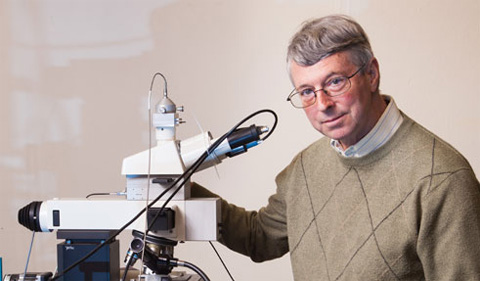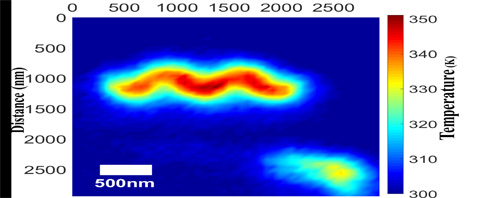
Dr. Hugh Richardson
By Samantha Peko
NQPI editorial intern
Picture an object that is approximately 1,000 times smaller than a human hair. Now imagine trying to test the temperature of this object you can’t even see. Ohio University Chemistry & Biochemistry professor and Nanoscale & Quantum Phenomena Institute member Hugh Richardson and graduate student Susil Baral, have made this their mission.
Richardson and Baral are developing a technique to test temperature at the nanoscale, which may be helpful in various applications: from better electronic devices to improved medical treatments, the pair explained.

Thermal image of a lithographically fabricated gold nanosnake imaged with Er3+ based nanothermometry.
“Temperature measurement at nanoscale provides an ideal way to understand interesting properties of the particles at the nanoscale,” Baral said.
For example, one common treatment for cancer is hyperthermia. This method involves using high temperatures to kill cancerous cells because cancerous cells are more sensitive to heat. Hyperthermia’s major limitation is that the treatment can often destroy healthy, noncancerous cells, as well. If the temperature of the healthy tissue near the cancer cells could be measured, treatments like hyperthermia could be further developed.
However, you can’t stick a traditional thermometer into something as small as a cell. Richardson and Baral believe that using optical manipulation and microscopic imaging may be useful to probe temperature at the nanoscale.
To test their new nanotemperature measurement technique, the pair has been working with synthesized objects at the nanoscale. They used light to increase temperatures. Then, images are taken to see how the heat is being distributed inside the nanosized object.
Another limitation is that measuring objects with light blurs the image if the object is smaller than the diffraction limit (approximately 250 nanometers). This blurring distorts the temperature measurement. This limitation can be overcome by using nanoparticle thermal sensors that are smaller than 250 nanometers.
Richardson’s team is working to move beyond technical limitations to improve the optical temperature measurement technique. Although Richardson could not release any more specific details about the technique just yet, he is confident that the optical method will push the frontier, and said to expect a publication detailing their findings in the near future.


















Comments